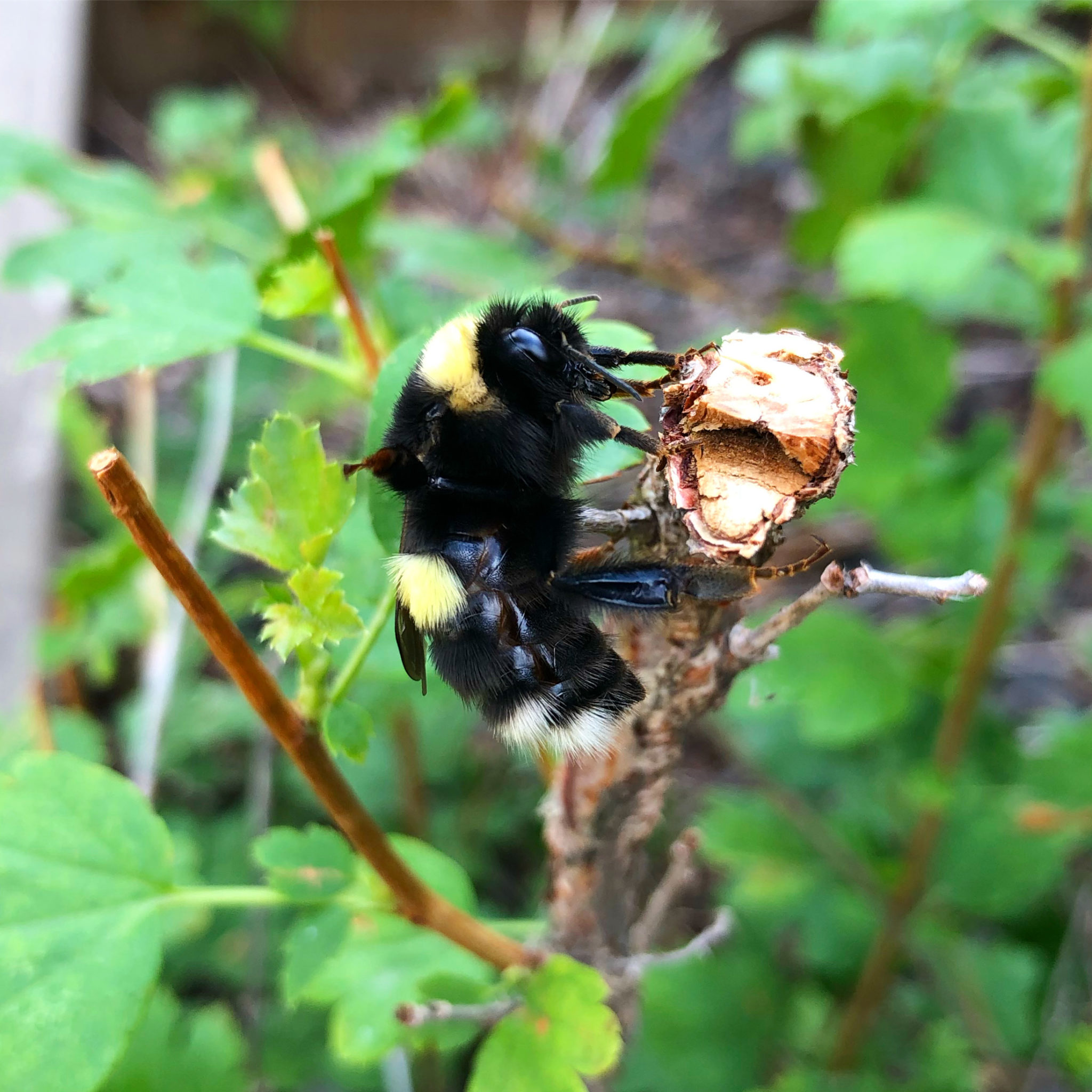It does not matter whether your backyard is filled with concrete and stone or if it’s your private forest escape, the one thing every back yard has is bugs. Some will irritate you so much you start to consider chemical warfare and napalm. Others make you smile and feel like Mother Nature has sent you a personalized piece of happiness. This article will help you understand which ones are good, bad, or a little bit of both. It will also help you learn to avoid the ones you do not want and how to attract the ones you do.
All insects and arachnids are in your yard for either food or shelter. The trick to keeping the “good bugs” and getting rid of the “bad bugs” rest in those two needs.
Let us start with the bad bugs, as getting rid of them may be what brought you to this article in the first place!
There are simply too many insects to go over in one blog post, so this one is only going to cover insects that cause a wide variety of problems or provide a wide variety of benefits. This post will not discuss bugs that target specific plants or vegetables.
The Bad Bugs
Mosquitoes
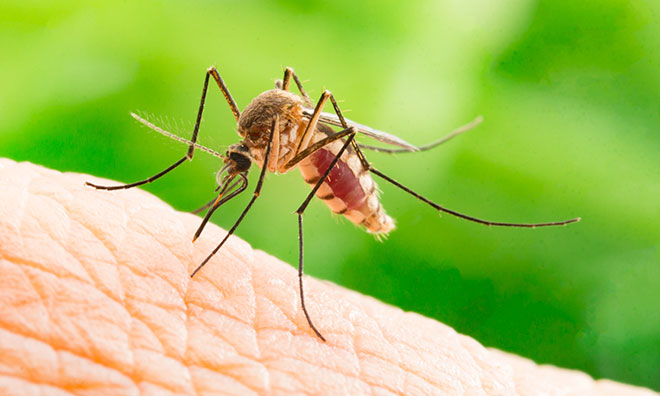
Mosquitoes are one of the very few bugs in Alberta that actively go out of their way to bother humans. These tiny determined little insects feed on blood and can be found buzzing around anything with a heartbeat. Edmonton has more than 30 mosquito species, none of which are good.
It is important to remember that the mosquitoes in your yard typically will not come from there. Instead they come mainly from larger bodies of water, like the low spots in farmer fields and ditches. The goal is to have fewer mosquitos and not help them thrive.
How to deter Mosquitoes in your yard:
- Ensure there are no stagnant or shallow bodies of water in your yard. Things such as tires and empty flowerpots are perfect for mosquitoes. Water features, on the other hand, that have moving water are not suitable for mosquitoes’ larvae. For instance, a busy bird bath will deter mosquitoes and dumping out the bird bath periodically or adding movement to the water with a bubbler can help keep the bath bug free. Ponds can be another attractant and breeding ground for mosquitoes. Adding fish that eat mosquitoes’ larvae will help, but your pond must be filtered.
- Keep your lawn cut short and your shrub beds tidy. Most mosquito species cannot survive in the full heat of daytime and hide in the humid shade of tall grass and plants.
- Some plants are unattractive to mosquitoes due to their scent. Plants such as Lavender, Marigolds, Citronella grass, and Bee Balm have scents and oils that mosquitoes do not like, however you would have to cover your yard with the mulched plants in order for them to be effective. Furthermore, sage can be effective if burned. Throwing some sage into your back yard fire will produce smoke that wards off most annoying insects.
- If your property is suitable, you can install a bat house. Most bat species in Alberta can eat up to 600 mosquitoes in an hour.
Aphids
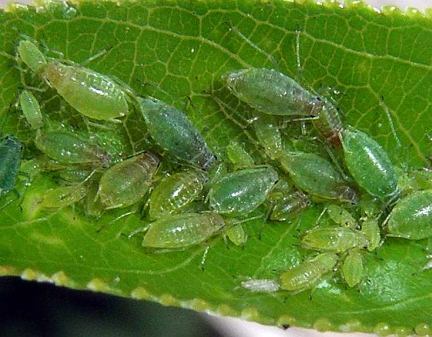
There are more than 140 species of aphids in Alberta that all feed on various plants. The problems with aphids are similar no matter if they are green, black, brown, white, or grey. Aphids are a sap sucking insect that breed extremely fast. Most plants can handle the average aphid infestation; however, a heavy infestation can result in permanent damage. Aphids cover everything with their sticky honeydew (excrement), which attracts other bugs, such as ants. Moreover, aphids have no defenses against predators and are devoured by wasps and Ladybugs alike.
How to deter aphids in your yard:
- A strong spray of water will knock most the aphids off your plants. This is most effective in the spring before a major infestation develops and, in the fall, to knock the eggs of your plants. However, this may damage more delicate plants.
- Insecticidal soap/water mixtures or essential oils can be used in sprays to get rid of aphids. Neem oil works as well, but will also have a negative affect the good bugs too!
- Introduce predators that you want in your yard. Wasps help control aphid populations, although most of us do not want them in our yard. Introducing Ladybugs or green lacewings will help control aphids. The larvae of each are far more effective in aphid control than the adults so be sure to provide a suitable habitat if you want your exterminators to stick around. Ladybugs and lacewing can be purchased online and at some nurseries.
- Many birds will eat aphids so be sure to provide a suitable environment for small birds, such as chickadees and wrens.
- Grow plants that deter aphids like onion, garlic, and chives.
- Grow plants that attract aphid predators like clover, mint, and dill.
- Some plants can be used to distract aphids from the plants you want to protect. This combined with other controls can be effective. Aphids are attracted to Zinnias, Dahlias, and Asters.
Tent Caterpillars
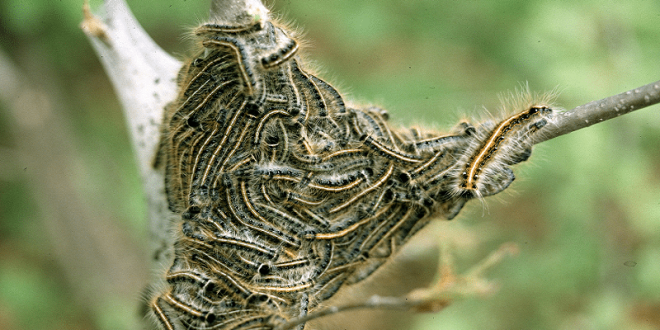
Sometimes your trees will develop large clumps of webbing you would only imagine the scariest of spiders building. In Alberta, the only creatures building webs that size are Tent caterpillars. Tent caterpillars feed on foliage on trees and shrubs but will eat any other type of foliage when heavily infested. They tend to target Trembling Aspen Trees the most, but will also eat Maple, Birch, Ash, Cotoneaster, and fruit trees. A minor infestation will not significantly harm a plant, whereas a heavy infestation can cause severe defoliation leading to decline.
How to deter Tent Caterpillars in your yard:
- Check on trees and shrubs that may develop infestations in the spring and fall. Tent caterpillars lay their eggs on the host plant in obvious white clusters of eggs. It is easiest to see the egg clusters in the spring before the plants starts leafing out or in the fall after leaves have fallen. If eggs clusters are found, they can be scraped away with a knife without harming the plant. You can dispose of the eggs, but it is better to leave the eggs exposed to open air and far from any plants that they could try to eat. This way the eggs will hatch with no food, and the parasitic wasps that target the caterpillars will still be able to thrive. Helping these tiny wasps prosper will help keep future infestations at a minimum.
- A strong spray of water can destroy the caterpillar’s “tent” and cause them to fall to the ground. On the ground most of the caterpillars will starve or be eaten by other insects. The largest of the larvae may be able to make it back to the tree so physical deterrence can also help.
- If a plant is already infested and is hard to reach, a trained and qualified professional can treat the infestation.
- Birds will eat Tent caterpillars so making your yard more bird friendly will also help.
Stink Bugs
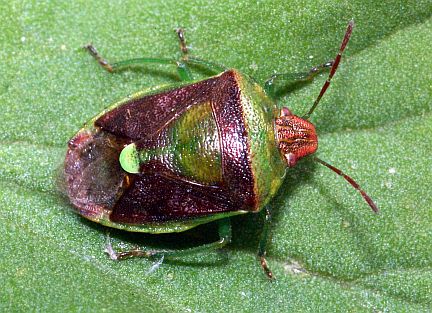
Stink bugs, or Shield bugs, are common in Alberta and are relatively harmless. These little bugs feed on plants by liquifying plant cells and sucking out the mix. Typically they do not harm plants unless their population becomes extreme.
How to deter stink bugs in your yard:
- Keep your yard tidy. Stink bugs over-winter in garden debris in large numbers so be sure to clean up leaf piles and similar hiding places in the fall. The reason Stink bugs are not a problem in Alberta is because our winters are too cold for them.
- Have a bird friendly yard. Birds will eat Stink bugs occasionally, but not often because these bugs taste bad. Their awful taste comes from a smelly chemical they excrete, hence their name.
- You can physically remove them but be sure to wear gloves. Stink bugs can bite humans and the edges of their shield like body can cause irritation to the skin. Moreover, there is also the smell to deal with.
Slugs

Few insects are despised more than slugs. Sticky, sloppy, nasty blobs of slime that fill plants full of holes at night. Slugs can be a major pest during wet summers and in shaded yards. They die if they dry out, so they only emerge at night and hide during the day. They mostly target low growing plants in moist conditions but will eat pretty much anything, even each other. Their feeding is obvious, leaving shiny slime trails leading to sporadic holes in plant leaves.
How to deter slugs in your yard
- Reduce their hiding places during the day. Dead leaves and plant matter is their favorite hiding place, but they will also avoid the sun by hanging out beneath boards, hoses or anything strewn about the property. Having good air flow and few places to hide makes them less likely to set up shop in your yard.
- Make your yard attractive to their predators. Birds, frogs, salamanders, garter snakes, and ground beetles.
- Have plants that they do not like. This will not keep them away but will make them less attracted to your yard. They do not like plants with strong scents or that are hard to eat. For Instance, Ornamental grasses and Periwinkle are hard to chew and plants like mint taste bad.
- Plant something that attracts them away from your other plants and use the trap plant to find them. Marigolds work well for distracting slugs.
- Add things to the soil that they do not like. Slugs dislike coffee grounds or dry eggshells in/on the soil surface and they do not like copper. Diatomaceous earth works well because it cuts up the slugs’ bellies as they try to cross.
- You can construct slug traps in problem areas. A pit fall trap with beer works well. Slugs love beer and will drown when they fall in.
- Repellents are available but be considerate of the insects you like when using it. Most repellents will harm more than just your target.
The Good/Bad Bugs
There are some bugs that we really do not want in our yards even though they provide real benefits. The opposite is also true in that some welcomed bugs have negative qualities. These are our ants, wasps, butterflies, moths, and earthworms.
Ants
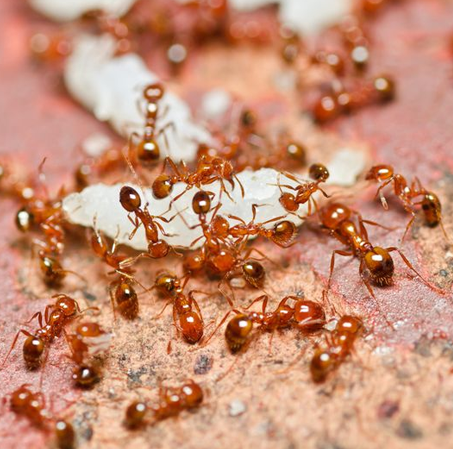
The last thing anyone wants to see inside their home is an ant. All ants have the potential of setting up their colony in a house under the right conditions and getting them out can be difficult and costly.
Carpenter ants are the largest ants in Alberta, and they can be a serious problem as they can ruin the wood in your building structures. They like to build their nest in decaying wood, whether it’s a stump, a damaged tree, or your house. Field ants build their nest in open areas of soil like lawns, which can result in decline of your lawn. Pharaoh ants are tiny little guys that can build a nest anywhere if the conditions are right and, as they are so small, finding that nest can be difficult, which can be exceedingly difficult should they gain entry to your home.
Despite their faults, ants provide tremendous benefits to your yard. When it comes to soil quality even earthworms are not as effective at natural fertilization and rototilling. Ants add air, nutrients, and moisture to the soil wherever they nest and even help plants spread their seeds.
Ants will show up anywhere that suits their needs. Since no one want to attract ants we will discuss how to deter them:
- Keeping your trees healthy and removing any dying trees will help keep Carpenter ants away. If your tree has Carpenter ants, it’s important to know they are not the ones killing your tree, but rather are just taking advantage of the dying tree. When they do move in, they accelerate the decline of the tree by ruining its integrity, stopping compartmentalization so the tree can heal, and can also dig their way into the healthy parts of the tree. Carpenter ants only start nests in decaying wood.
- Ensure the wooden structures in your property are sound and that unnecessary access points to the buildings are removed. For instance, tree branches touching your roof are great access ways for ants.
- Do not keep easy to access food sources nearby. This can be in your home or in your yard, if food is easily accessible, the ants will come. This can include rotting fruit from your fruit trees or indoor garbage cans that are not emptied often.
- Lots of things eat ants! If there are always predators around, the ants will not want to build a nest nearby. Making your yard friendly to birds, frogs, salamanders, and garter snakes can help keep ant populations under control.
- Keep aphid populations under control. Ants love to farm aphids for their honeydew, but they do not kill them. Utilizing aphid controls can also keep your ant’s population under control
- Make sure your trees do not have Wood Borers. It’s extremely common for trees that get Wood Borer to also have ants in them. This is because when a borer builds its galleys it allows fungus and decay to get inside the tree. Decay inside your tree is an open invitation to carpenter ants.
Wasps and Hornets
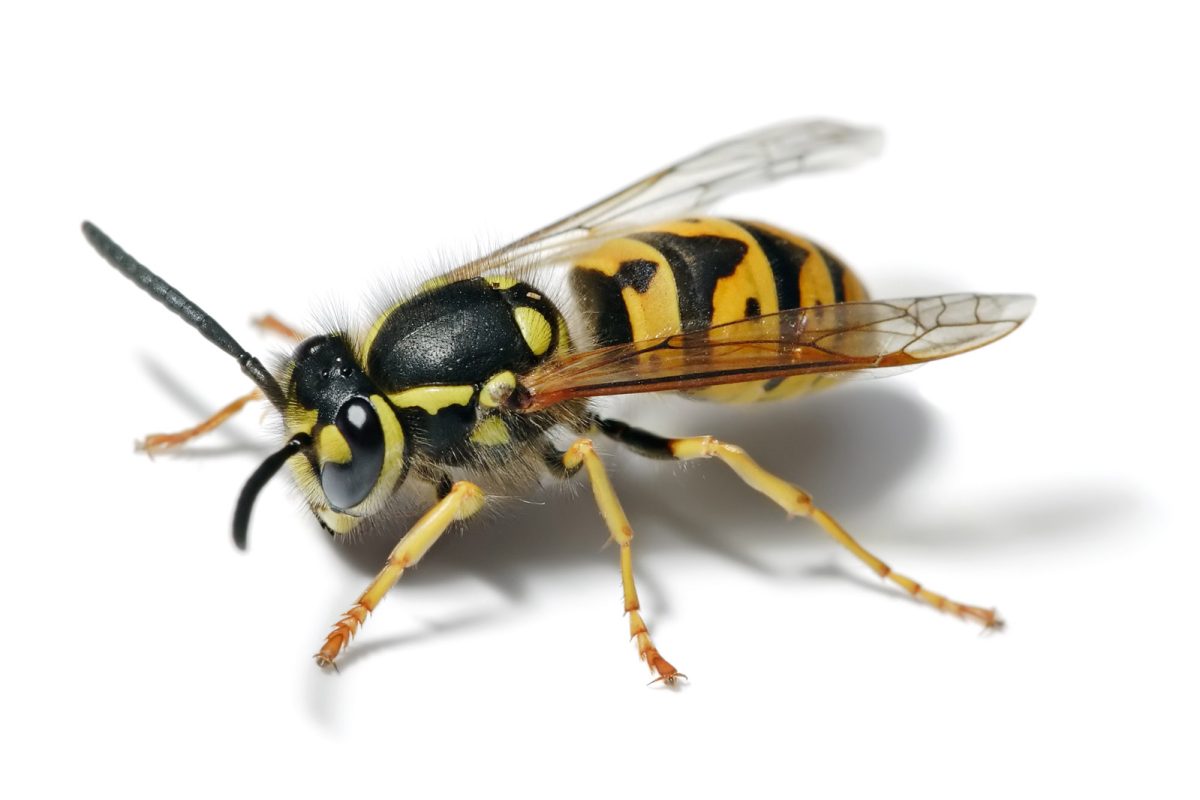
These buzzing bugs look like bees but are greeted with a fear and hostility no other bug knows. These little bugs can be aggressive when threatened and have adapted perfectly for battle, but it is these qualities that make them good! There are situations where you do not want them around, such as picnics, if you have healthy bee activity nearby, or if someone is allergic to their venom. Wasps and hornets are predatory and sometimes parasitic insects. They are omnivores but their main food source is other insects. Wasps eat a lot of nasty bugs, but they also hunt and eat good ones. With wasps and hornets, it is a matter of balance and circumstance. If you have a very large yard where people are not going to be very often then leaving a nest away from everything does no harm. The wasps will mostly leave you alone and will spend the summers eating the nasty bugs. If you have a small yard or if the nest is close to your house, it may be a good idea to remove the nest so the wasps have to go elsewhere.
Even if wasps are great at keeping other insects in line very few of us want them setting up shop in our yard, so let us go over how to deter them:
- Do not keep easy food sources for them nearby. Wasps are mostly carnivorous, but they do eat sugars. Throughout the summer, wasps hunt insects and bring the protein back to the nest to feed the larvae and queen, which is why wasps will be attracted to meat and other types of protein. Throughout the summer the workers feed protein to the larvae and the larvae gives them a sugary substance in return. Towards the end of the summer, as protein gets harder to find and the larvae are less numerous, the wasps will start looking elsewhere for their sugar fix.
- Keep aphid populations under control. Wasps eat or exploit aphids; if you have a lot of aphids you will also have wasps.
- Keep a bird and amphibian friendly yard. Many things eat wasps including some birds, dragonflies, spiders, frogs, and salamanders. Attracting these predators can convince wasps to set up shop elsewhere.
- Ground wasps need dry ground for their nest, watering frequently can help keep your yard unsuitable for them.
- If a nest does start to develop, removing it before it’s fully established is the best option. Social wasps start with just a queen until she makes her first handful of workers. A developed nest can have hundreds of workers protecting it.
Note: there is no evidence that decoy nests work, especially on Social wasps or Ground wasps. In fact, some wasps have even been known to build their nest inside the decoy or on top of old nests.
Butterflies and Moths
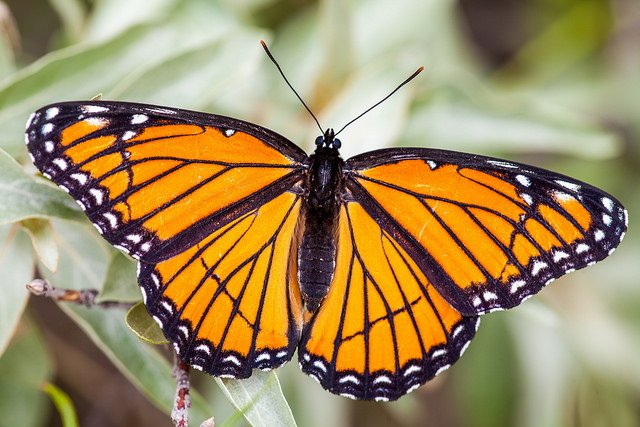
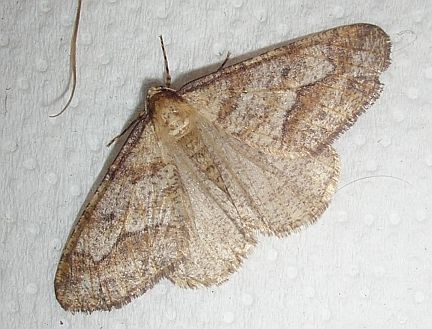
Having a butterfly flutter into your yard is a beautiful and magical moment and most of us will do everything we can to have the peaceful beauties frequent our property. Moths are not treated with such reverence as they come out at night and flutter against our windows like they plan to rob us. There are differences between the two, but their function and what attracts them is mostly the same so we will talk about them together. Butterflies and moths can be wonderful dashes of life and color in any yard and are great at pollinating our plants. What they also have in common is that their prior form was a caterpillar that eats our plants! Unless the caterpillars are overly abundant, they do not harm the trees, so we can say that, despite their adolescent records, butterflies and moths are good bugs.
You can attract butterflies and moths to your yard by:
- Having lots of plants with fragrant flowers. You can choose multiple types of plants that are fragrant and bloom at different times, so you have food available year-round. Lilacs are great for spring flowers and Bee Balm and Milk Weed will bloom throughout the summer. Butterflies are attracted to thick foliage with good sunlight because they cannot see well and need the suns’ warmth to get going.
- To have butterflies not only visit your yard but also stay to lay eggs, you will need plants for the caterpillars to eat. Be sure to have edible plants nearby. Butterfly caterpillars are far less destructive than moth caterpillars, but chances are you will end up with both. Keep a close eye on the population and keep less desirable species like Tent Caterpillar away.
- Have a resting area of rock or stone where the butterfly can rest and warm up in direct sunlight.
- Have a very shallow puddle somewhere that has just enough water for the butterfly to get a drink but not enough to provide a home for mosquito’s larva. Many butterfly baths come with the water and resting area built into one. A small amount of sand or clay in the butterfly bath will help the butterflies because they like to eat minerals found there. Minerals like sodium and nitrates help the butterfly digest along with other benefits.
- Make your yard attractive for birds, this will help keep the caterpillars under control. If needed you can physically control the caterpillar population yourself but do not use pesticides as that will harm the butterflies too.
It is important to note that if you have butterflies during the day you will likely have moths at night. Both are great pollinators and are good if the caterpillar populations do not become a problem. Most of us do not like having all the moths staring through our windows at night though so there are some things you can do to help:
- Replace white lightbulbs with yellow. Moths are extremely attracted to white light and will flock to it; yellow light however is not nearly as attractive to them.
- Make your yard attractive to bats. While birds will keep butterflies and their young under control during the day, bats will control moths at night.
- Powered bug zappers are not advised as they will kill both good and bad bugs and are particularly bad at attracting biting insects like mosquitoes.
Earthworms
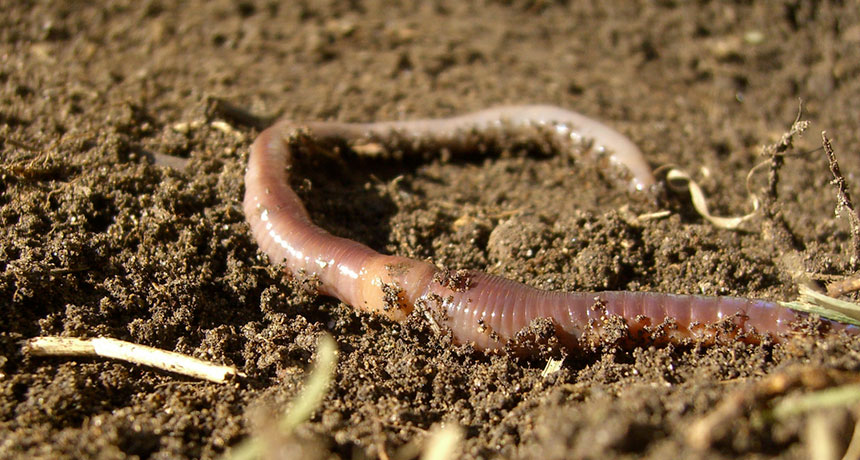
Earthworms like butterflies are generally considered a good bug but, like butterflies, there is a lesser know negative to their hard work. Earthworms come in 3 varieties litter dwelling worms, soil dwelling worms, and deep burrowing worms. As their name suggests the differences is where they choose to live in the soil but they all function in a similar way. They dig through the soil eating organic matter and adding air at the same time. This function is great for soil quality and helps plants grow.
The dark side of earthworms is they harm our forests. Earthworms are invasive to north America and were brought in by settlers from Europe. While they work wonders in our soil, they also break down the organic matter in our forests much faster than normal. This causes a loss of food and habitat for our native forest floor dwellers. Most the earthworm problems in our forests are not from gardens but rather from fishing. It is important for all fishermen not to throw left over bait into the forest!
These simple workers are good for your yard though, so here are a few simple steps on how to attract earthworms to you yard:
- Keep your soil damp. Earthworms dry out without their dark damp environment.
- Dig and disturb the soil as little as possible.
- Having extra organic matter for them can only help. Leaving leaf piles for them to break down or adding kitchen scraps to the soil will keep them thriving.
The Good Bugs
Honeybee, Bumble Bee, and Mason Bee
There are no better bugs for your yard than bees! Not only are these guys essential for your plants to thrive but also for our environment. Bees handle the bulk of pollination in Alberta and without them our gardens, trees, and flowers would fail along with our agriculture. There are many types of bees in our area but three of the most common ones are the Honeybee, Bumblebee, and the Mason Bee.
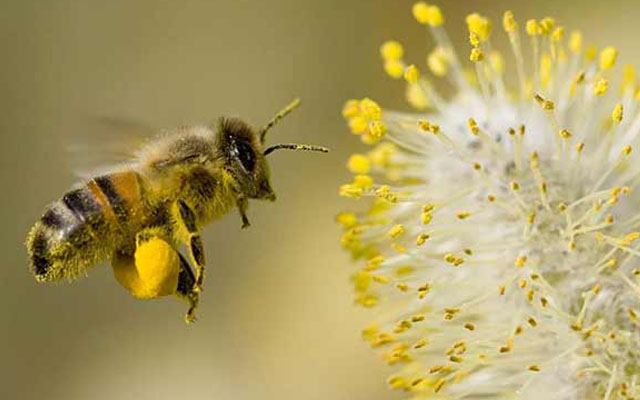
Honeybees are the domesticated species we all recognize. These guys are usually from a man-made hive, but they are sometimes found in the wild. These bees are not the best at pollinating, but they make up for it in numbers. These little guys can pollinate the plants for miles around their hive, and each hive can have up 80,000 bees.
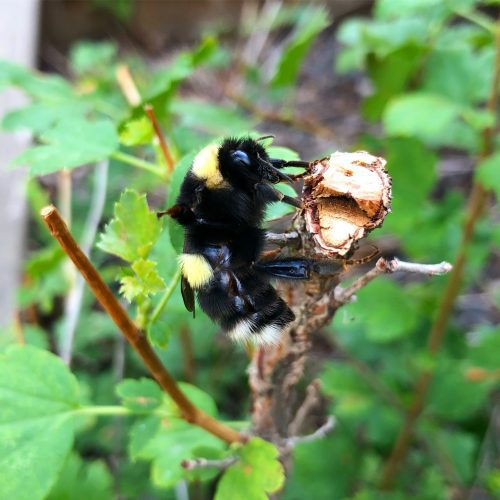
Bumble Bee’s are the adorable little fur balls buzzing around and bumping into everything. There are many species of Bumblebees in Alberta that are all adapted to pollinate a different variety of plants. While they have smaller hives and are not domesticated, they are better at pollinating than Honeybees because they are less picky about what they target and better adapted for a range of plants. Their hive size varies from species to species but usually has no more than a few hundred bees.
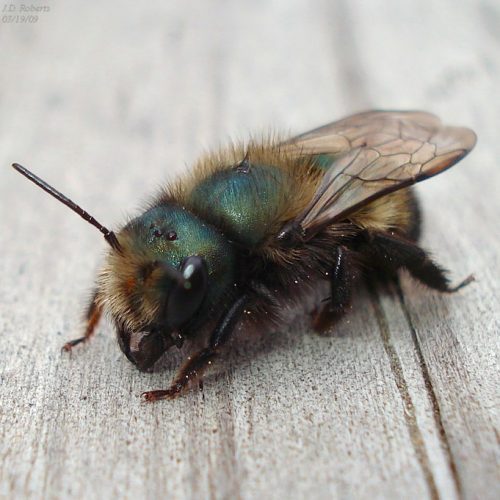
Mason Bees are the lesser-known bee in Alberta and often get overlooked when it comes to pollinating because some species do not even look like bees. These solitary pollinators are the most effective pollinators pound for pound as one Mason Bee can pollinate as much as a dozen Honeybees. These little workers do not build hives, but instead live in solitary nests fashioned from hollow twigs, cracks in rocks, and wood borer holes.
How to attract bees to your yard:
- Growing a variety of flowering plants is the best way to attract bees. There are over 300 different species of bees in Alberta that all target a range of plants. Honeybees prefer plants with a lot of nectar and pollen. Wildflowers seem to attract Bumblebees in droves, as well as plants such as clover. Most bees prefer perennials over exotic plants, such as Sunflowers and Black Eyed Susan’s. Having a variety of flowering plants that bloom at different times helps keep the bees fed spring through fall. Flowering trees like crab apple and choke cherry can feed a hive all spring!
- Have flowering plants close together. It is more efficient for bees when they can quickly jump from flower to flower than hunting down individual blossoms. Large plants with many blossoms are great too, like flowering apple trees and lilacs.
- Bees like sunny areas that are sheltered from the wind. Having trees in your yard can help hold the wind at bay but be sure there is also lots of sunlight to keep the bees warm.
- Do not spray pesticides in your yard. While you may have a pest problem, the downside of insecticide is it usually targets all insects not just one. While you may not always have a choice, you should investigate alternative controls whenever possible.
- Consider leaving weeds like dandelion around in the early spring so bees have food when they start out. It is a myth that bees need the dandelions as most trees are providing pollen for them, however dandelions do help in areas where other sources are scarce.
- Clover is another lawn weed that is great for bees. Clover is very resilient and aggressive so it will choke out other weeds. It also smells great! If you do not mind how clover looks then leave it bee.
- Plant Bee Balm. This wonder plant will attract both bees and butterflies and is very easy to care for.
- Provide a water source. Having water for the bees when they get dehydrated will keep them around. A water feature, pond, or butterfly bath will let them rest and hydrate when needed.
- Provide housing for solitary bees. You can buy prefabricated bee hotels or build your own! Solitary bees build their nest in hollow holes or crevices wherever they can be close to water and food while staying warm and safe. Placing a bee home somewhere the sun will shine will help them survive our cold winters.
- Have plants with foliage. Like all insects bees need a balance between having enough sun to stay warm and avoiding too much sun and burning out. Having plants that provide shade will give bees a place to rest on those scorching summer days.
Lady Beetle
Lady beetles or as many know them Ladybugs are one of the best bugs to have in your yard. While they do not pollinate like bees, these pretty predators eat a ridiculous number of nasty pests. Ladybugs target mostly aphids, but some species will also eat small nasties like scale and mites. These guys will grow into great armies to exterminate Aphids and they do not eat your plants. There are over 160 species of Ladybugs in Canada and all of them are our friends. Lady beetle larvae look like drab grey caterpillars with an orange splotch on their back. The larvae eat more than their adult form, but one Lady Beetle will eat close to 5000 aphids between both stages of development. The adult Lady Beetles will lay their eggs on the underside of leaves if there is food nearby.
How to attract Lady Beetles to your yard:
- Lady beetles, like most insects, need food, shelter, and water to survive. If you have aphids, then the Lady beetles will come, but having a decoy plant can help. Plants like Marigolds will draw aphids away from other plants and in turn draw Ladybugs to eat. Lady beetles will need low growing plants with thick foliage so they can hide from predators like birds and frogs. Mulch and leaves will work for shelter too but be aware that may attract other bugs you do not want. Lady beetles will need a place to hydrate that is not so deep that they may drown. If you have a butterfly bath close to the ground, they will use it too.
- Build Lady beetle houses. There are many types of Lady beetle houses you can buy or make but they all follow the same idea: a structure with small holes for entry and an enticing food source inside like raisins. Just be sure the holes are small enough that wasps cannot fit inside.
- You can purchase Lady beetles at many nurseries or online. Be sure when releasing the bugs that the area has water as they will be very thirsty when they wake up. You will also need to release them nearby aphids, so they immediately have food.
Lacewings
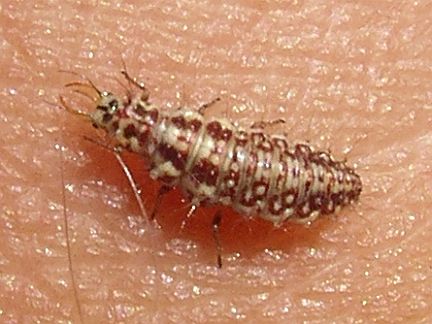
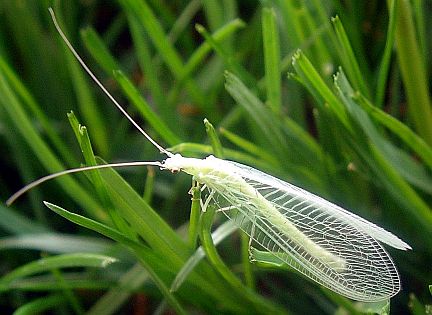
Lacewings and their larvae are not well known in Alberta but are just as beneficial as Lady beetles. Lacewings look like strange moths with invisible wings and can be brown, gray, and more often green. Like Lady beetles, the adults eat the same thing as their larvae just in smaller amounts. Lacewing larvae called Aphid Lions are aphid eating machines. Aphid Lions can be hard to identify as they often build “houses” that they carry around as camouflage, but they often look like moving bunches of debris with large mandibles sticking out. These bugs are so beneficial that they can also be purchased as insect control.
How to attract Lacewings:
- Attracting Lacewings is very much the same as attracting Lady beetles. Chances are you will end up with both under the same conditions.
Ground Beetle

Anyone who been digging in a garden has probably seen a ground beetle. Like their name suggests these guys hunt the ground for nasty insects to eat. They are a large size beetle than is usually black or metallic. There are over 800 species of ground beetles in Canada, nearly all of which are predatory insects that hunt at night. These dark horses of the bug world are determined hunters and strong enough to take on some insects that are too big and mean for other insect predators. By night, they hunt for anything from ants to slugs to grasshoppers. They come out earlier in the spring than Lady Beetles and Lacewings, so they are usually your first line of natural pest control. Ground Beetles are nocturnal and tend to scurry away if discovered by humans. They do sometimes find their way into buildings but are harmless and only reproduce and lay eggs outdoors. They are known to heavily invade a building when attracted by very bright and powerful lighting. Ground Beetles are also one of the best natural predators for caterpillars and can wipe out Tent Caterpillars with ease.
How to attract ground beetles to you yard:
- Like most predatory helpers you just need to provide them with food, water, and shelter. If you have a yard with a lot of diversity and some places for them to hide during the day, then they will be around. They like mulch and dead foliage on the ground to both hunt in and hide in but can also be found under rocks and similar hideouts.
- To help keep them out of your house and focused on hunting avoid large bright lights near your house. Things like spotlights can distract them and attract them to hang out near buildings. Ensure there are no convenient entries for them like cracked foundations.
Dragon Fly
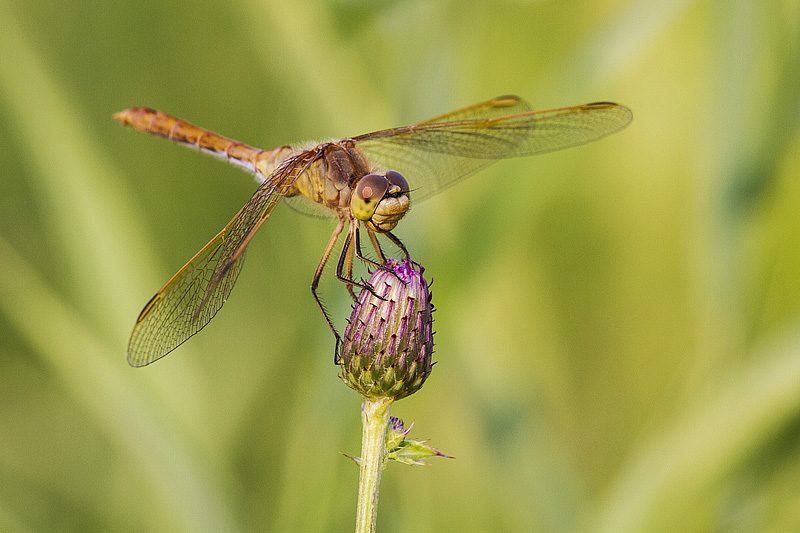
These colorful beauties are also very powerful. The form we recognize is an apex insect predator that hunts by day and eats anything it can catch including wasps, moths, bees, mosquitoes, and butterflies. While they do eat mosquitoes, the adult form is not very good at it because mosquitoes are mostly out at dawn and dusk while dragon flies hunt during the day. Dragon flies eat their own body weight each day, so if they are eating mosquitoes, grasshoppers, or wasps that is a lot of pest control!
The real reason dragon flies make the good list, aside from their good looks, is their nymph stage of life. Dragon flies spend most of their life as nymphs hunting in the water. These nymphs are very effective at keeping mosquito larvae under control. If you do have standing water, such as a pond, you can expect to see these flashy fellas a lot. Dragon flies do bite if attacked but since they do not actually have teeth it’s just a pinch from their mandibles and will rarely break skin.
How to attract dragon flies to your yard:
- Have standing water for the young. A pond with water plants at the edges is best for this as the nymphs will want places to hide from predators. The water plants are also necessary for the nymphs to leave the water and turn into dragonflies.
- Having lots of insects will attract the dragon flies. Since they eat so much the need a busy hunting ground.
- When dragon flies get cold, they will often rest on flat rocks that have been warmed by the sun. Having a warming rock somewhere will also attract large bugs like bees and butterflies.
Spiders
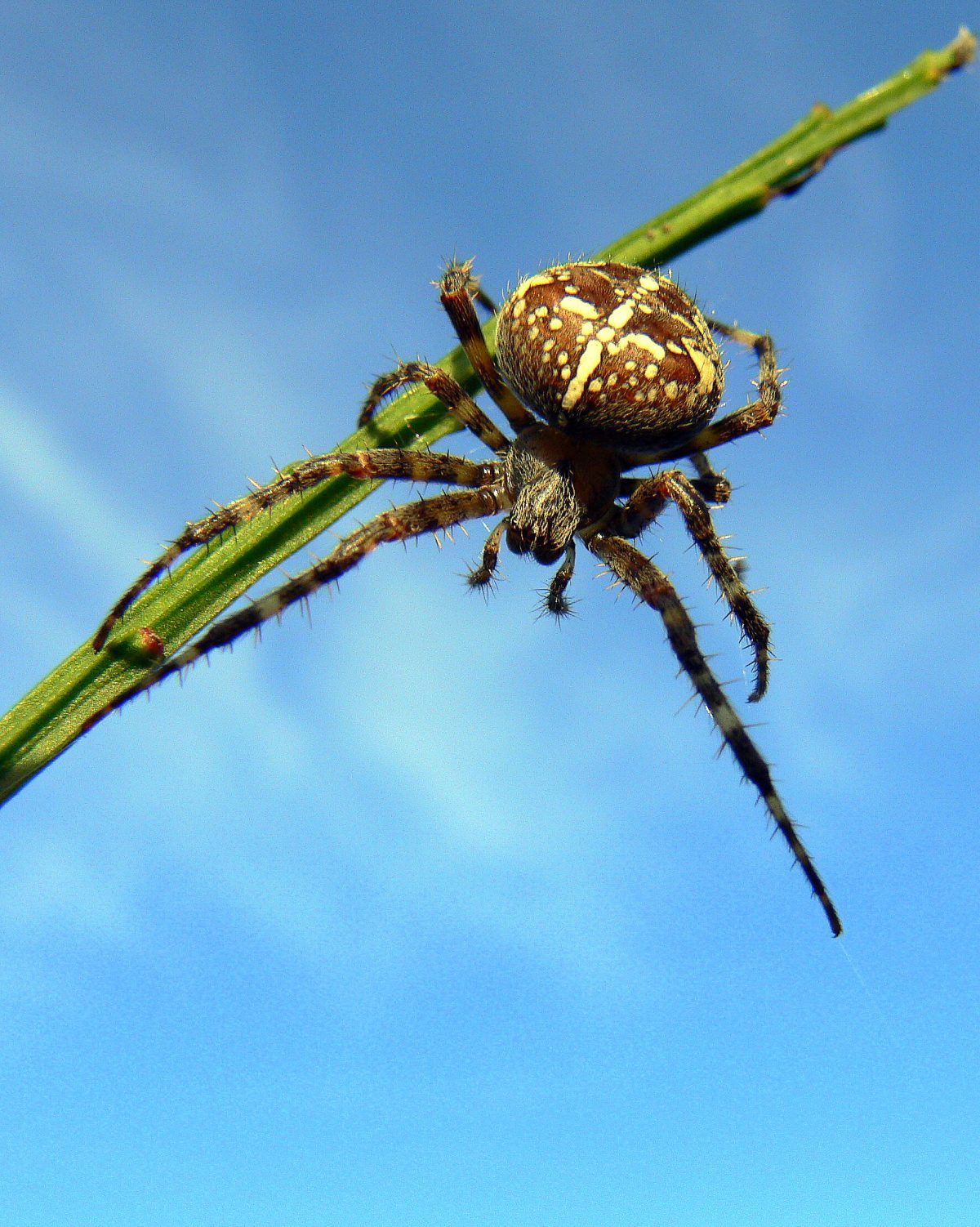
While a fear of spiders is common, it is unfair to these wonderful bugs. Spiders are not an insect but rather an arachnid and there are over 600 different species in Alberta. Some spiders build webs, and some do not but all of them are great at keeping insect populations under control. Spiders are an extremely shy bug that avoids humans, although some are known to live in basements or to build webs on buildings. These guys are a sign of a healthy living environment and mostly just hang out near their home eating bugs.
How to attract spiders to your yard:
- If there are bugs in your yard, there will be spiders. The main thing is not to disturb the spiders that have taken up residence. Try not to destroy their webs if you can help it and they will help keep bugs in check.
How to keep spiders out of the house.
Some species of spiders love living indoors but they are all harmless. If they moved in it is because there is something for them to eat there, such as carpet mites or flies. There are two species in Alberta that are both venomous and able to bite humans and those are the Black Widow and the Brown Recluse. Both are very rare in Edmonton as they prefer the warmer climates in southern Alberta and both species rarely bite humans. To keep spiders out you can gently place them outside and remove their webs. If you cannot find the spider but have found the web then removing it will likely convince the spider to live elsewhere


